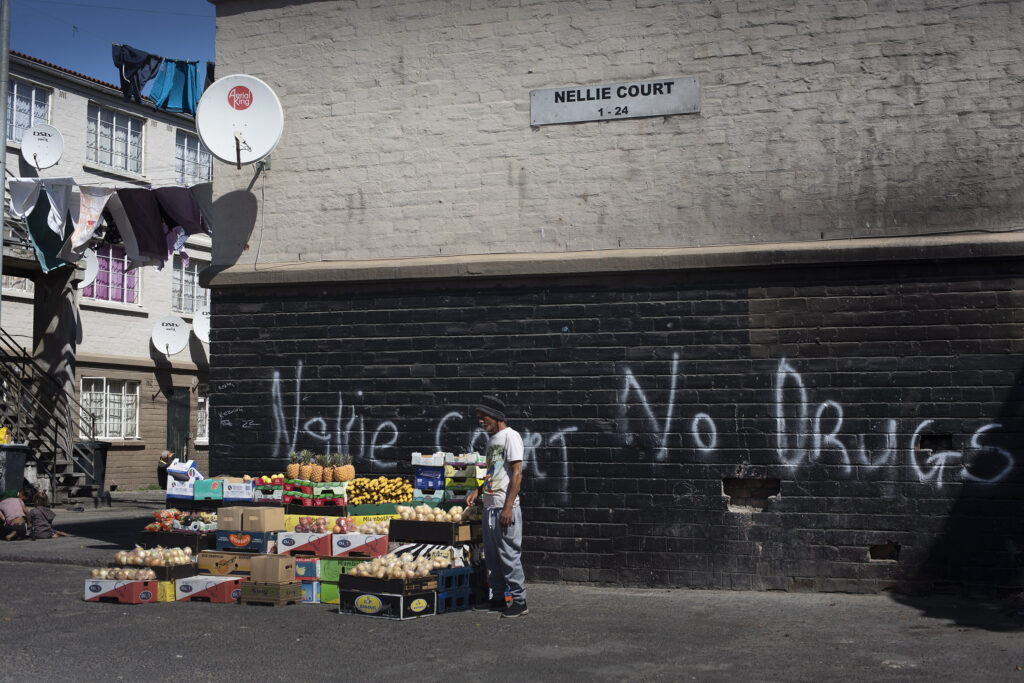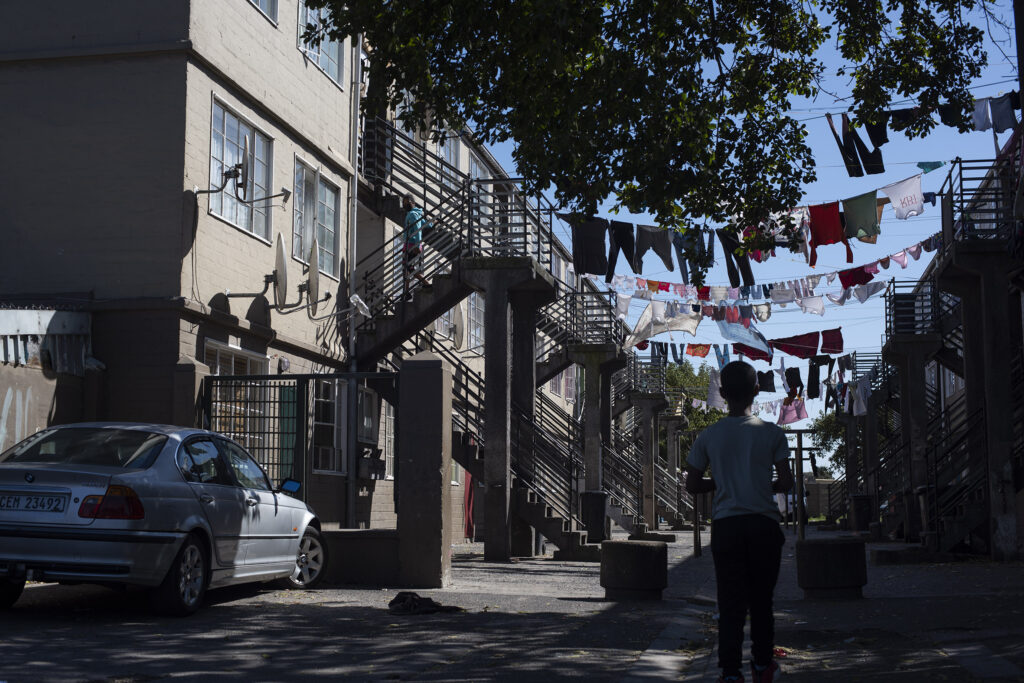Gangland: In Elsie’s River near Cape Town, where poverty and gangsterism are rife, young men congregating on street corners using or selling drugs, or ‘skarrelling’ through rubbish for usable items, is a common sight.
Gangsterism is associated with men, that’s how the stereotype goes. Men in search of an identity turn to gangs in an attempt to define their masculinity. It is uncommon to hear women join gangs to live out some version of femininity. But women do play a role in gang culture; in some cases, crucial roles.
“Hi girl. Do you want to hang out with us? What are you doing this weekend? We are having a party. I will send people to fetch you.”
Flanked by three young men, Jenina [not her real name] would stand outside a school.
“You get different types of girls. You read them.”
She’d target the quiet girls, inviting them to a party where they would be plied with drugs and get high on weed, tik (crystal methamphetamine) or buttons (Mandrax) and “I will let them be abused by the men gangsters,” explains Jenina.
She “pulled” four girls — weekly.
She’s been sober for seven years now, but Jenina, a former gangster, does not dismiss her behaviour in her previous life. She takes responsibility for her acts as a drug and gun dealer. However, she adds, being permanently under the influence of drugs affected the way she felt about her actions.
Under the influence, she says, “you don’t feel pain for your children, yourself or others. The only thing that matters is ‘the family’.”
The family, for her, was the gang she belonged to.
Imanuella Muller is a registered counsellor who works at the South African College of Applied Psychology in Cape Town. She recently completed her master’s degree in psychology at Stellenbosch University doing research on the recruitment and initiation of girls into gangs in the Western Cape.
“Gangsterism is a worldwide phenomenon with serious consequences for community well-being,” she says. “In the Western Cape gangs present a complex phenomenon that impairs community functioning and hampers community development. Young girls and women have been largely absent and voiceless in gang research.”
Speaking to the Mail & Guardian, Muller says communities are almost dependent on gangs.
“They almost have this hold over the communities.”
Gangs are there when girls can’t afford to study further, when they drop out of school, and when they don’t have the means to create a sustainable livelihood for themselves.
Jenina grew up on the Cape Flats. Despite being exposed to gangs on a daily basis and losing her father in a shooting when she was 11 years old, she never participated in gang activities.

Years later a physically and emotionally abusive relationship was the first step to making Jenina a soft target for gang recruiters.
“I did not want to be a lady. [The abuse] stripped me of being a woman. And I started to deal in drugs.” At the time a family member supported her and her three children. It was this family member, a “high flyer in a numbers gang” that introduced her to drugs.
“After months of being on drugs and smuggling you meet the people backstage,” says Jenina, referring to the inner workings of gangs.
Charmen [not her real name] represents a vast number of women in gang-infested communities. She lives in the Nyanga area on the Cape Flats — which includes Elsie’s River, Bishop Lavis, Gugulethu, Manenberg, Nyanga and Philippi East.
Charmen lives where gang fights between the Clever Kids, Jesters, Americans and Hard Livings (HLs) are common. Her one son and husband are part of the HLs, one of the largest gang groups in Cape Town.
Despite her daily awareness of them, she says: “I would never run with the gangs,” meaning she did not participate in gang activities. Her brother and son have been shot and wounded, the former during a gang fight and the latter in crossfire.
Charmen works in the hospitality industry. But “you worry a lot,” she says, explaining the uncertainty when you don’t know whether your husband and son will return home. “I would put sleeping pills in their porridge,” admits Charmen hesitantly, “so that they can feel sleepy and not go out to fight.”
Jenina, meanwhile, grew fearless. The inferiority complex produced by her abusive relationship became a shadow of the past. When she was in the gang she called for hits or beatings on people who failed to pay for the contraband she offered.
 Photo by David Harrison
Photo by David Harrison
“Ek slaat vir jou, jy het mos nou klaar my geld opgetik,” says Jenina, re-enacting a scenario where someone did not pay for drugs he consumed. When she was arrested, the “high flyer” gang member would bribe his friends in the police and she would be out of the cell in no time. It happened four times in the more than a decade she participated in gang activities.
Muller’s research determined that women play various roles in gangs.
“These include being information carriers, hiding and handling contraband, ‘trapping’ rival male gang members, selling drugs and taking part in robberies. This clearly shows that women are in fact part of core gang activities, and do not just exist on the periphery of gangs.”
Women who spend time in the company of gang members and come to learn more about how they operate are seen as a risk. Due to their association, women are forced to become part of the gang.
The day Jenina proved her loyalty to her gang, a 14-year-old boy paid the price after he shared information with another gang. He died riddled with bullets, the same number as the gang number. The notorious numbers gangs include the 26s, 27s and 28s.
That was her first murder.
“You have these two voices talking to each other: one saying to leave your lifestyle, the other one asking how you are going to survive without it. I have put myself in there, and there was no way out, except by getting shot and killed.”
 Elsies Rivier near Cape Town. Photo by David Harrison
Elsies Rivier near Cape Town. Photo by David Harrison
Once, when she attempted to leave, she was beaten and told it was not for her to decide when to leave.
Jenina made the decision to leave her gang when her son confronted her about her lifestyle. She acted quickly and started walking without knowing where she was headed.
“I’m beyond lucky. I don’t really have words. I’m just so grateful.
“I cannot explain it. It was like I was pushed from behind by someone. I walked and I was not scared of being exposed. I was fearless again. It was like I was a child being guided by someone holding my hand.
“Now how can I go back to that lifestyle if God took me out of it?”
It has not been an easy journey to sobriety and being permanently employed. The night she left the gang, Jenina found a night shelter that soon became her beacon of hope. Despite leaving the shelter four times, only to return later, the staff always made room for her.
Being sober fits Jenina’s contagious laugh. However, she also now clearly feels the pain and hopelessness she experienced as a woman gangster for the first time. She also carries the thoughts of what she has done to others.
She says that her biggest burden is that her children followed in her footsteps, and “I take full blame for that, my children saw my example.”
Muller believes that the gang culture that is so deeply embedded in the Western Cape can be broken, but that “it is a process that will take time because it is so deeply rooted in communities”.
In the Nyanga area where Charmen lives with her gangster husband and son, the late afternoon throws shadows on people walking down the street. Gangsters who skarrel (rummage through rubbish bins) or sell fruit and vegetables during the day are returning home. The little money they made is spent on chasing the dragon, smoking Unga, a heroin-based drug.
Noticing the youngsters at the street corner, Charmen says: “When the youngsters gather like that on the street corner, then I just turn around and walk away.”